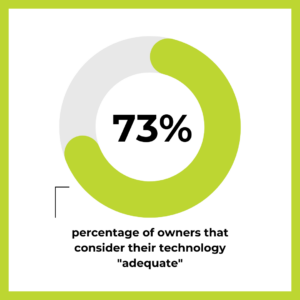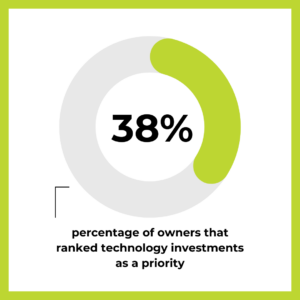When it’s time to think about exiting your business there are many things to consider.
One important, but often overlooked, area of the business is your technology and how it will impact the sale when a new owner takes over your business.
According to the 2024 State of Succession and Exit Planning in the Horticulture Industry study released by PivotPoint Business Solutions, 73% of growers rate their technology as “adequate”.

73% of owners consider their operation technology “adequate” | Advance Grower Solutions
Often, the more familiar or comfortable we are with a given piece of technology, the more we are likely to ‘accept’ it, warts and all, as long as it allows us to get the job done.
The horticulture industry is replete with owners running legacy systems that are no longer supported. As I work with growers and their teams, I am amazed at how clever and resourceful they can be inventing “workarounds” for system inadequacies. These workarounds, once codified into the work process, make the inefficiency permanent and acceptably “adequate” to the current team.
Technology ‘Adequacy’ Is Determined by the Buyer
As software and systems permeate our lives and provide improvements, the expectation of technology and system capability has become higher, especially as businesses transition to younger generations of ownership — the so-called “digital natives”.
What a current owner deems as adequate or acceptable could be seen as antiquated or lacking by new ownership, which may drive down the perceived value of the business.
The judgment of ‘adequacy’ should be made through the eyes of a potential acquirer. What will they need, think, or perceive about the state of your technology? And how might they use assessed inadequacies to negotiate the price down?
Bringing in experienced outside third parties to assess and document technology and systems can bring challenges or inefficiencies into focus. Such an assessment will give you an unbiased view that can be used to direct technological improvements before you sell, and the findings can be passed on to potential buyers as a roadmap for change.
Technology Investment Is a Priority
Despite the high percentage of growers deeming their technology as adequate, 38% ranked technology investments as a priority.
This tells us that many growers understand that improvements are necessary. And they are willing to recognize the need for investment to address shortcomings.

38% of owners ranked technology investments as a priority | Advance Grower Solutions
The response begs the question, what technology investments should be made to maximize exit value?
This is where the findings of an unbiased third party can help a grower determine which course of action will provide the highest probability of return on their investment.
What’s the Procedure?
Another important aspect that can impact exit value is the use of standard operating procedures (SOPs) to improve efficiency, ease onboarding, and ensure repeatability. Without SOPs, the risk increases, and quality can suffer.
In the industry survey, we found only 37% of growers have documented SOPs.
This tells us that too many growers rely on memory or verbal transmission to complete tasks. As an operation expands, or as experienced staff retire, new employees will join the team. The lack of SOPs will yield growth pains and result in downstream issues. This may signal additional training costs to a buyer who feels the need to bring the business up to standard. Potential buyers may also see this as an overreliance on a few key employees, a risk that can potentially impact the exit value of your business.

37% of growers do not have documented standard operating procedures (SOPs) | Advance Grower Solutions
From a buyer’s perspective, technology and SOPs are tightly intermingled. Having a good technology stack will help ‘force’ needed adherence to key procedures. Required fields, approvals, data validation, reminders, and exception reports are key features software systems provide to create consistency, improve quality, and provide more accurate data for decision-making.
The Bottom Line for Maximizing Value
A lack of modern technology and standardized processes can become value destroyers in negotiations. Potential buyers may seek price reductions to offset costs, upgrade technology, and train staff.
Taking proactive steps to assess and improve your technology and document procedures can protect — and even increase — your business’s exit value and ensure a smooth, profitable exit.

